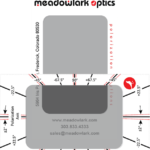Fiber-Based Optical Manipulation Application Note
Fiber-Based Optical Manipulation Application Note Overview: Fiber optic communications have long been of interest, but more recently the technology is being coupled with SLMs for imaging deep in tissue where scattering would otherwise prevent optical techniques from being practical. Much research is focused on imaging through multi-mode fibers due to the small form factor that […]
Fiber-Based Optical Manipulation Application Note Read More »

